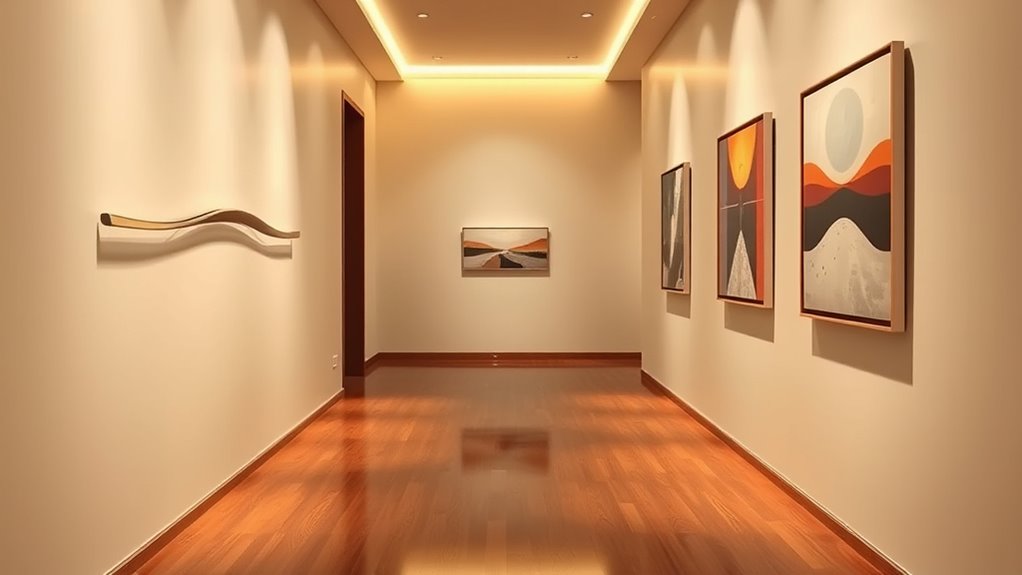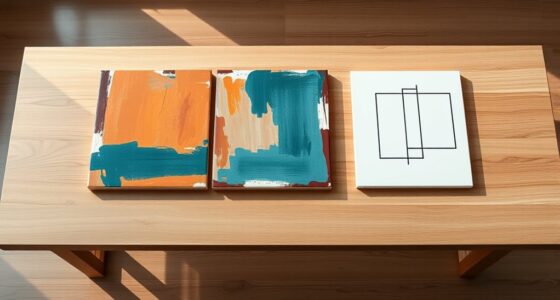To maximize a narrow hallway, measure your space carefully, considering wall textures and height. Choose artwork in proportion with the length and height, and maintain consistent gaps of 2-4 inches between frames. Use vertical pieces and strategic lighting to add depth and visual interest. Keep the overall arrangement balanced and avoid clutter by selecting bold or cohesive artwork. Want to transform your hallway? Keep exploring for expert tips on perfect spacing and layout.
Key Takeaways
- Maintain consistent gaps of 2-4 inches between artworks to prevent clutter in narrow hallways.
- Use appropriately scaled, medium-sized art pieces to balance space without overwhelming the area.
- Hang artwork at eye level for maximum impact and visual harmony within limited space.
- Incorporate vertical elements like tall shelving or vertical artworks to emphasize height and create a sense of spaciousness.
- Enhance brightness with light colors, reflective surfaces, and targeted lighting to make narrow hallways appear larger.
Measuring Your Narrow Space for Perfect Fit
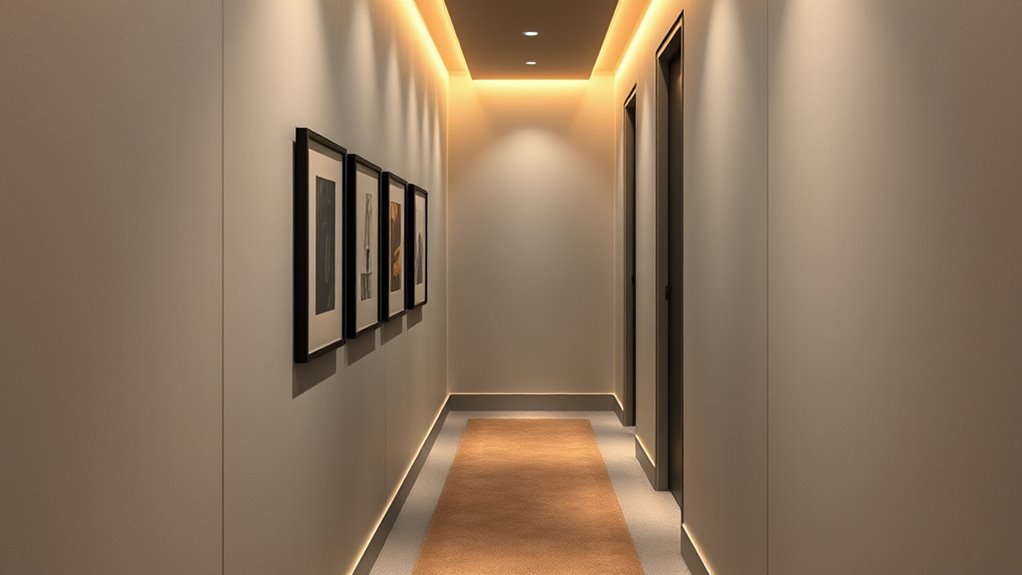
Have you measured your hallway carefully before choosing your artwork? Accurate measurements are essential for a perfect fit. Start by noting the width and height of your space, ensuring you account for any wall textures that might affect hanging options. Consider the lighting options available, as they can influence how artwork appears and how much space you need around it. If your walls have textured surfaces, measure the depth to avoid mounting issues. Remember, a narrow hallway can feel more spacious when artwork is scaled appropriately. Use a tape measure for precision, and mark the spots where you plan to hang pieces. Additionally, understanding the wall surface type can help determine the best hanging method and prevent potential damage. Considering cost and budgeting factors can also help you select artwork that fits your financial plan while enhancing your space. Being aware of traditional and modern techniques can inspire the selection of artwork that complements your decor style. Incorporating the right security measures can also protect your artwork from damage or theft, especially in high-traffic areas. Taking these steps ensures your artwork complements your space without overwhelming it, creating a balanced and inviting corridor.
Choosing Artwork That Compliments Slim Hallways
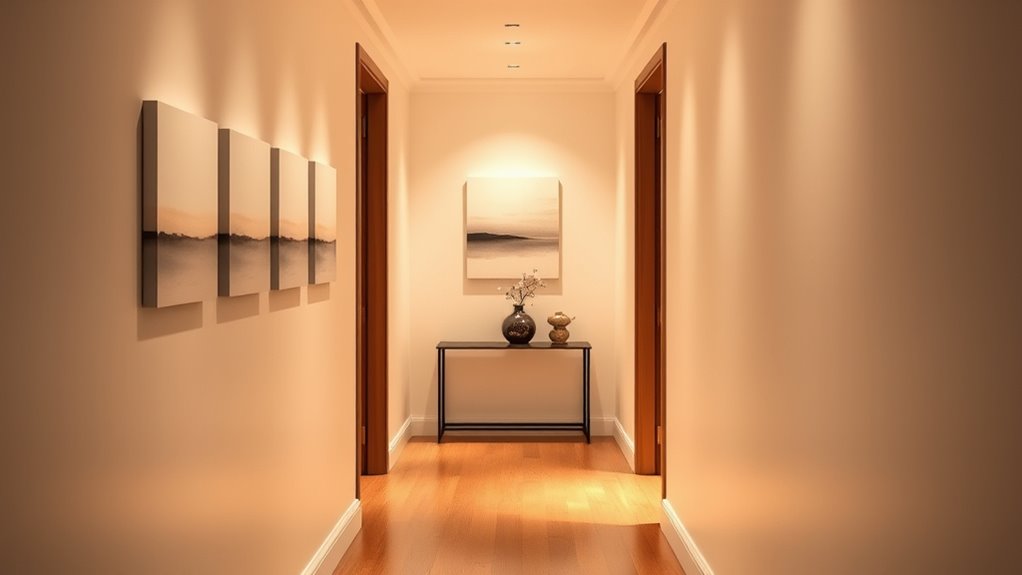
When selecting artwork for slim hallways, opt for proportional sizes that don’t overwhelm the space. Vertical pieces work best to enhance height, making the hallway feel more spacious. Light and bright colors also reflect light, keeping the area lively and inviting. Incorporating unique and wicked planters can add a touch of greenery and personality without cluttering the narrow corridor. Additionally, choosing artwork with antibacterial properties can promote a healthier environment, especially in high-traffic areas like hallways. To further improve the ambiance, consider lighting techniques that highlight your artwork and create a welcoming atmosphere. Selecting compact and lightweight decor can also prevent the space from feeling crowded while maximizing visual interest.
Proportional Artwork Sizes
Choosing artwork that suits a slim hallway requires paying attention to proportions. To achieve a balanced look, focus on scale harmony—select pieces that aren’t too large or small relative to the wall space. Oversized art can overwhelm narrow areas, while tiny pieces may get lost. Instead, opt for medium-sized artworks that create visual interest without crowding the space. Color coordination also plays a crucial role; selecting artwork with cohesive hues enhances flow and prevents visual clutter. Keep in mind that proportional sizes help maintain a sense of order and harmony, making the hallway feel inviting rather than cramped. Additionally, visual balance is essential in small spaces to prevent the area from feeling cluttered or overwhelming. Considering gallery wall arrangements can further help in achieving a cohesive look that complements the narrow space. Incorporating the right artwork scale ensures your art feels integrated and harmonious within the confined area. By carefully balancing size and color, you ensure your artwork complements the slender space beautifully, adding personality without sacrificing openness. Paying attention to personality test principles can also guide the selection of artwork that resonates with your personal style and enhances the space’s emotional impact.
Vertical Artworks Preference
Vertical artworks naturally complement slim hallways by emphasizing their height and drawing the eye upward. Choosing tall, narrow pieces like nature scenes or abstract designs enhances the sense of space without cluttering the narrow corridor. Nature scenes with vertical elements, such as trees or waterfalls, create a calming flow that guides your gaze along the length of the wall. Abstract designs with elongated shapes or vertical lines add visual interest and heighten the sense of openness. Avoid wide or overly busy artworks, which can make the space feel cramped. Instead, select pieces that are proportionate to your hallway’s dimensions, allowing the artwork to breathe and accentuate the verticality. Understanding artistic proportions can help in selecting the perfect pieces that complement your space. Additionally, considering visual balance ensures that the artwork enhances the overall harmony of the corridor, making it feel more inviting. Incorporating spatial harmony can also prevent the artwork from overpowering the narrow space, maintaining a cohesive look. This approach keeps your narrow space feeling balanced, stylish, and inviting.
Light and Bright Colors
Bright, light colors can transform a slim hallway into an airy, inviting space. Using colors informed by color psychology, like soft whites, pale blues, or gentle pastels, creates a sense of openness and calm. These hues reflect natural light, making your narrow corridor feel larger and more welcoming. When choosing paint finishes, go for satin or eggshell; they add subtle shine and durability without overwhelming the space. Light colors also serve as a perfect backdrop for artwork, allowing your decor to stand out without cluttering the visual flow. Keep in mind that the right combination of hue and finish can enhance the perception of space, turning a cramped hallway into a bright, fresh passageway that feels open and lively. Incorporating light-reflecting finishes can further amplify natural brightness and make the area appear more expansive. Additionally, selecting appropriate wall art can complement the space and boost the overall brightness. Using on-device AI insights can help you choose the perfect colors and art styles tailored to your space’s lighting and dimensions. Furthermore, choosing reflective surfaces like mirrors or glossy frames can enhance the sense of openness in narrow hallways.
Creating a Cohesive Gallery Wall in Tight Areas
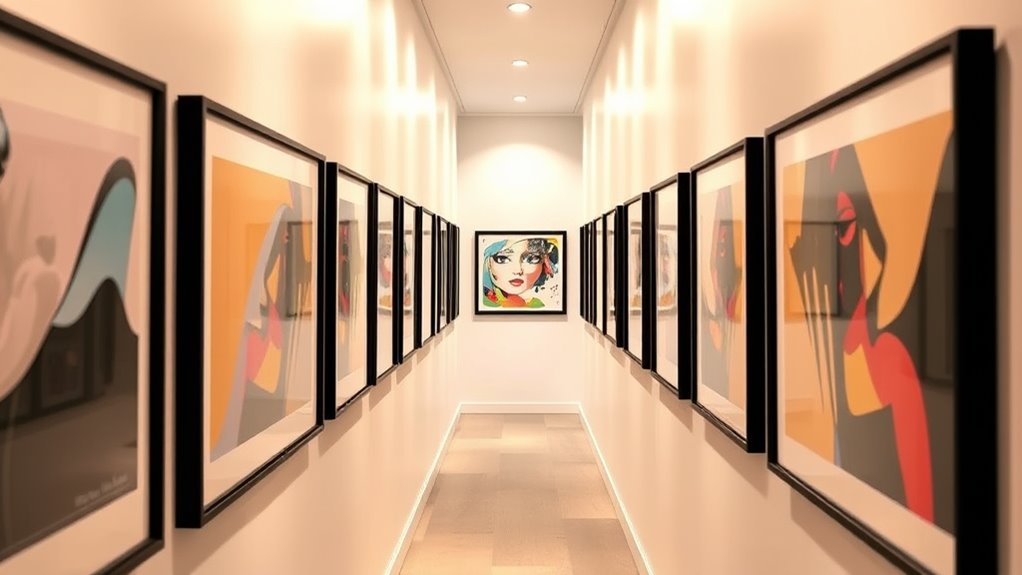
When space is limited, creating a cohesive gallery wall requires careful planning and thoughtful arrangement. Focus on establishing a consistent lighting ambiance to highlight each piece without overwhelming the narrow space. Use lighting that creates a warm, inviting glow, enhancing the overall mood and drawing attention to your artwork. Color coordination is equally important; select frames and artwork with complementary hues to unify the display. Stick to a cohesive color palette to prevent the wall from feeling chaotic or cluttered. Arrange your pieces in a balanced way, ensuring similar spacing and alignment. This intentional approach helps the gallery wall feel cohesive and harmonious, even in tight spaces. Additionally, considering proper spacing will ensure your artwork is neither too cramped nor too sparse, enhancing visual harmony and visual flow. Incorporating antiques or vintage elements can also add uniqueness and charm to your gallery, elevating the overall aesthetic of your narrow hallway.
Proper Spacing Techniques for Multiple Pieces
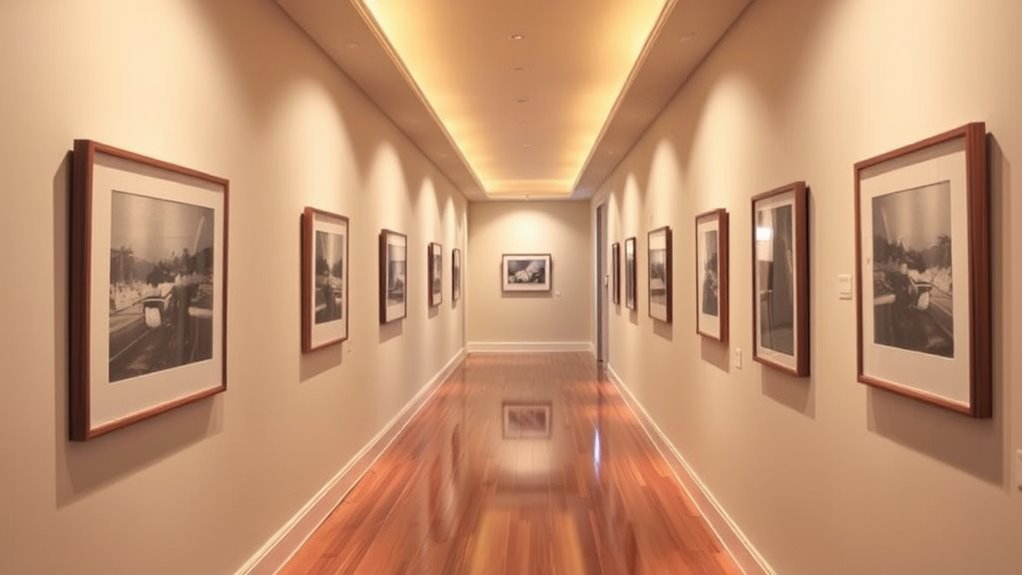
Once you’ve chosen your frames and arranged your artwork, paying attention to proper spacing guarantees your gallery wall looks balanced and professional. Aim for consistent gaps between pieces, generally 2 to 4 inches, to create harmony without clutter. Consider the framing styles—bold or minimal frames can influence spacing choices, so adjust accordingly to avoid visual overload. Proper gallery lighting enhances each piece, making the spacing even more effective by highlighting individual artworks. When hanging multiple pieces, keep a central focal point and work outward, maintaining even distances. Use a level to ensure alignment, and modify spacing based on the size of your art. Thoughtful spacing, combined with suitable lighting and framing styles, results in a polished, inviting hallway display. Additionally, understanding gallery wall spacing principles can help you achieve a professional look that complements your interior design.
Hanging Single Statement Art for Impact

To make a statement in your hallway, place bold artwork at eye level for maximum impact. Choose pieces with strong visual weight that draw attention without overwhelming the space. Balancing the artwork’s size and placement guarantees it commands attention seamlessly.
Optimal Placement Techniques
Hanging a single statement art piece can dramatically enhance your hallway’s visual appeal, but its impact depends heavily on placement. To maximize its effect, consider the following ideal placement techniques:
- Position the artwork at eye level for immediate impact
- Use appropriate lighting options, like wall sconces or spotlights, to highlight the piece
- Choose framing styles that complement your hallway’s decor, drawing attention without overwhelming
- Guarantee ample space around the art to prevent clutter and allow viewers to appreciate it fully
Choosing Bold Artwork
Choosing bold artwork can transform a simple hallway into a striking visual statement. Opt for pieces with vibrant color schemes that stand out against your wall’s background. If your walls have textured finishes like brick or stucco, select artwork that complements or contrasts effectively to enhance depth and interest. Large, single pieces create focal points, so pick artwork with strong visual impact—think abstract designs, dramatic photography, or vivid paintings. Keep in mind, the boldness of your piece should balance with the hallway’s scale; avoid overwhelming narrow spaces. By carefully selecting artwork that plays with color schemes and wall textures, you’ll generate a dynamic, eye-catching display that elevates your hallway’s aesthetic and invites curiosity.
Balancing Visual Weight
When placing a single statement piece in your hallway, it’s essential to contemplate its visual weight to create harmony and impact. A well-balanced art piece draws attention without overwhelming the space. Consider how color coordination influences the overall feel—bold colors add energy, while muted tones create calm. Framing styles also play a role; sleek modern frames emphasize minimalism, whereas ornate frames add sophistication. To achieve balance:
- Mix contrasting colors to make the piece stand out
- Use consistent framing styles for cohesion
- Position the art at eye level for immediate engagement
- Incorporate subtle accessories to complement the piece
Utilizing Vertical Space for Visual Balance
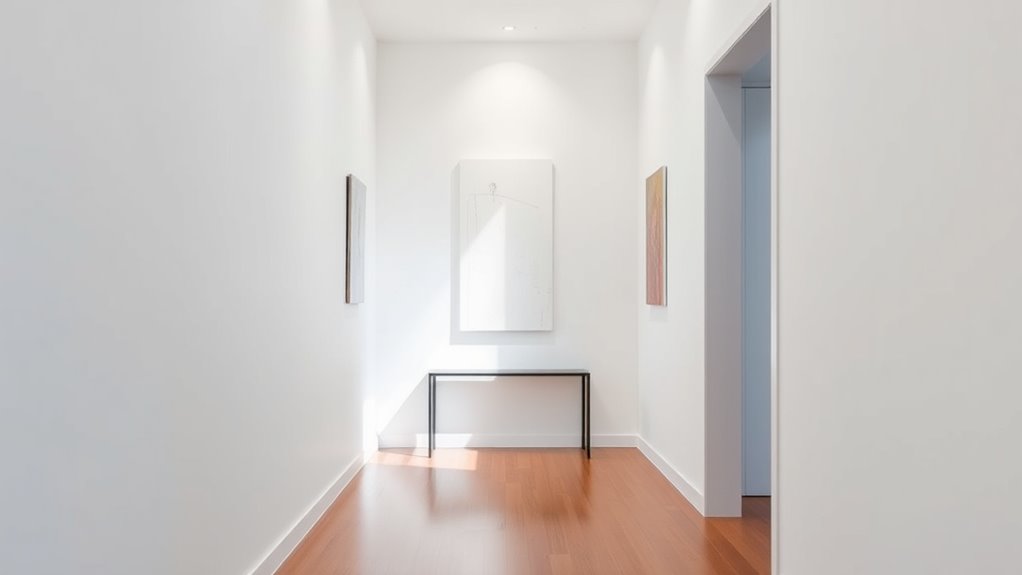
Maximizing vertical space in your hallway creates a sense of height and openness that can transform the entire corridor. You can do this by choosing lighting ideas that draw the eye upward, such as wall sconces or pendant lights. Incorporate bold color schemes on the upper walls or ceiling to add depth and focus attention vertically. Hanging artwork or shelves at varying heights also enhances visual interest and balance. Here’s a quick guide:
| Element | Tips | Examples |
|---|---|---|
| Lighting ideas | Use fixtures that direct light upward or downward | Wall sconces, pendant lights |
| Color schemes | Opt for lighter shades on upper walls | Soft pastels, neutrals |
| Wall decorations | Hang art at eye level and above | Tall, narrow frames |
| Vertical storage | Use tall shelving units or tall potted plants | Slim bookcases, floor plants |
Tips for Maintaining Symmetry and Harmony
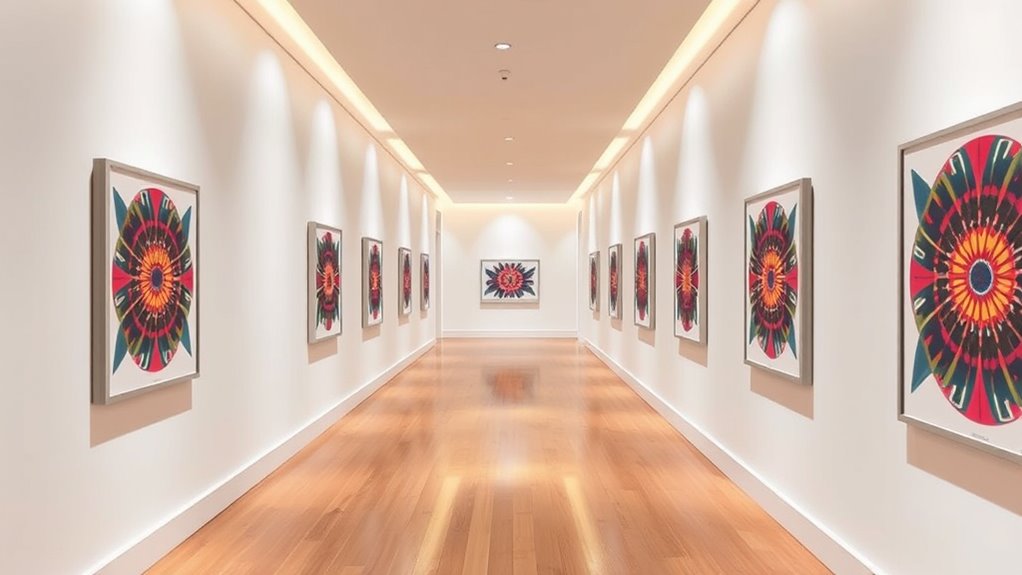
To create a hallway that feels balanced and cohesive, maintaining symmetry and harmony is essential. Focus on aligning artwork and decor to achieve visual order. Use consistent color coordination so that pieces complement each other, avoiding clashing hues. Pay attention to framing styles, opting for similar frames or finishes to unify the display. Consider the following tips:
- Arrange art at eye level on both sides for visual symmetry
- Match frame styles and colors for a cohesive look
- Balance larger and smaller pieces evenly across the space
- Use similar color palettes for art and accessories to enhance harmony
Avoiding Clutter: Keeping Your Narrow Corridor Open

Maintaining symmetry and harmony in your hallway sets a strong foundation, but it’s equally important to prevent clutter from overwhelming the space. Choose a cohesive color scheme that keeps walls and decor simple and light, making the corridor feel open. Bright, neutral tones reflect more light and create the illusion of space. Use lighting techniques like wall sconces or recessed lighting to eliminate shadows and brighten dark corners, reducing visual clutter. Keep surfaces clear by limiting decorative items and opting for streamlined storage solutions. Avoid overcrowding with too many frames or accessories; instead, select a few impactful pieces. By combining a consistent color palette with strategic lighting, you’ll maintain an open, airy corridor that feels inviting and spacious.
Frequently Asked Questions
How Can Lighting Enhance Hallway Artwork in Narrow Spaces?
You can enhance hallway artwork in narrow spaces with strategic lighting techniques. Use accent lighting to highlight the art, creating depth and focus. Wall-mounted sconces or track lighting work well to direct light precisely where needed, making your artwork stand out. Keep the lighting soft yet focused to avoid overwhelming the space. Properly placed accent lighting not only highlights your art but also adds warmth and visual interest to your narrow hallway.
What Colors Work Best for Small, Confined Hallways?
You should choose light, neutral colors like soft whites, beiges, or pastels, as they reflect more light and make your narrow hallway feel more open. Color psychology suggests that cool tones create a calming atmosphere, while warm tones add coziness. Opt for paint choices that enhance brightness and space, such as matte finishes to reduce glare. These strategies help your confined hallway appear larger and more inviting.
How to Incorporate Mirrors to Expand Visual Space?
You can make your narrow hallway feel more spacious by strategically placing mirrors on the walls. Position mirrors opposite or adjacent to reflective surfaces to maximize light and create an illusion of depth. Avoid clutter around the mirrors to enhance their effect. Use large, frameless mirrors for a sleek look, or multiple smaller ones for visual interest. Proper mirror placement instantly opens up your space and brightens the hallway.
Can Textured Art Make a Narrow Hallway Feel Larger?
Yes, textured art can make your narrow hallway feel larger. By using texture contrast, you add visual interest and depth, drawing the eye along the space. Be sure to place a focal point strategically, like a bold piece at eye level, to create a sense of dimension. This combination tricks the eye into perceiving more space, making your hallway feel open and inviting without overwhelming the area.
What Are Cost-Effective Ways to Update Hallway Decor?
Want to transform your hallway without breaking the bank? Start with budget-friendly upgrades like repainting walls or swapping out old hardware for a fresh look. Try DIY decoration tips such as creating your own artwork or hanging inexpensive mirrors to add depth. Keep it simple but impactful—sometimes, a small change can make a big difference. Stay tuned; your hallway’s stunning makeover is just a few creative steps away!
Conclusion
With the right spacing and thoughtful choices, your narrow hallway transforms into a mesmerizing gallery that whispers elegance. Think of each piece as a brushstroke in a masterful painting, where harmony and balance create a seamless flow. By carefully arranging your artwork, you turn a simple corridor into a visual symphony—a space that invites curiosity and admiration. Embrace your creative vision, and let your hallway become a refined canvas that reflects your unique style.
